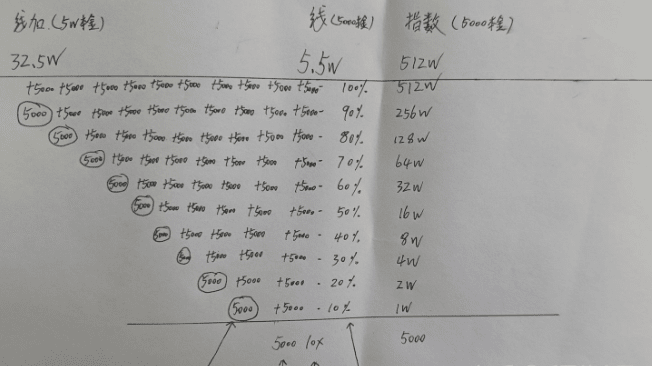First, a summary: Rolling positions are high-yield operations, but they also come with extremely high risks, so caution is essential. The strategy of rolling positions (exponential growth) combined with the compounding model is the most cost-effective strategy. Note that rolling positions represent exponential growth, while compounding is a special manifestation of exponential growth; in other words, all compounding is exponential growth, but not all exponential growth is compounding. Spot trading is the compounding model, while futures are more like a linear growth model.
Now let's officially talk about rolling positions.
With 5000 principal, 10x leverage, and a 100% increase, the final profit is 5 million, which is rolling positions.
Increasing positions with floating profits is not rolling positions. Because the current market's definition and methods of rolling positions are all directly copied and pasted from various opinions of popular figures, for novices with little investment experience, it is still not easy to understand. This article aims to explain it in a straightforward and blunt manner.
Assuming the current price of BTC is 10,000, with a position of 5000 and 10x leverage. At this point, BTC rises to 11,000, an increase of 10%, and you have made a profit of 5000. OK, the next steps are very important.
1. The practice of increasing positions with floating profits involves adding another 5000. Subsequently, BTC rises to 12000, increasing by 10%. At this point, your total capital with both principal and profits is 25,000. (Principal of two 5000s + profit from three 5000s)
2. The method of rolling positions is to close the previous position, totaling 10,000 with both principal and profits, then rebuild the position. Subsequently, BTC rises to 12,000, with the same 10% increase, bringing your total to 20,000 with both principal and profits.
Doesn't it seem similar at first glance? However, if you keep operating in cycles, when BTC rises to 20,000, the increase is 100%. The total with floating profit added is 325,000 (including 50,000 principal). For rolling positions, the total is 5.12 million (including 5,000 principal).
Why is there such a big difference? Next, let's analyze it together.
What is a complete position-building cycle?
Building positions → floating profits → floating profits → closing and exiting
What is a complete floating profit increasing cycle?
Building positions → floating profits → increasing positions → floating profits → closing and exiting
What is a complete rolling position cycle?
Building positions → floating profits → closing positions and then rebuilding → floating profits → closing and exiting
OK, here are two more concepts explained in a simple and understandable way. One is linear growth, which increases by 10%, 10%, 10%. The other is exponential growth, which increases by 10%, 20%, 40%, 80%. Linear growth is like driving a car, gradually accelerating from 10 mph to 20 mph to 80 mph, very smoothly. Exponential growth, on the other hand, is similar to technological development, which grows exponentially; it starts off slowly and accelerates as time goes on. Here's a not-so-precise example for easier understanding: based on solid evidence, humans first fully mastered fire 400,000 years ago, electricity 200 years ago, cars about 100 years ago, the internet 55 years ago, and mobile internet 30 years ago. This means that after mastering electricity, human technology experienced rapid development. Comparing those 400,000 years to this is like child's play. I digress; back to the point.
At this point, let's make an analogy:
Ordinary position building is linear growth. Strictly speaking, contracts are not linear, but let's use this analogy for easier understanding.
Increasing positions with floating profits is simply adding positions based on linear growth.
Rolling positions represent exponential growth by multiples.
Below is a manually calculated chart that visually shows this. Each circled 5000 represents the additional principal added with floating profits.

At this point, do you all think, wow! It's that simple! Isn't this the secret to wealth? But in reality, the operation of rolling positions has a set of strict prerequisites: capital management, profit-taking and stop-loss strategies, and the most important prerequisite—a one-sided bullish market. The greatest risk behind such high returns is that if you encounter a drawdown of more than 10%, you could lose everything. However, I personally believe that with reasonable profit-taking and stop-loss strategies, it can still be controlled. If you really encounter such a major market event that happens once every four years, it can be utilized.
Summary: The high returns of rolling positions also come with extremely high risks, so caution is essential. The strategy of rolling positions (exponential growth) combined with the compounding model is more cost-effective. Note that rolling positions represent exponential growth, while compounding is a special manifestation of exponential growth; in other words, all compounding is exponential growth, but not all exponential growth is compounding. Spot trading is the compounding model.
Many friends say that the increase shown in the chart is based on 10,000, but you can actually see the 10% and 20% in the chart as stage increases, which are essentially the same. This is just to make it easier to understand compounding visually; if you want detailed information, see the chart below.

The analysis above shows that the true meaning of rolling positions lies in compounding, while the true meaning of compounding is to fully mobilize unrealized profits, which are the floating profit portions. The case of Bit King growing from 40,000 to 200 million through leverage essentially embodies the compounding mindset. The compounding mindset is the only possibility for making big money with a small capital. If you have this mindset, it is the only way! Making profits in waves one week and losing in waves the next week without any systematic approach to trading futures makes it very hard to even break even, let alone make big profits.
Second summary: Making big money with a small capital has three points: 1. Compounding mindset. 2. Bullish market conditions. 3. Correct operations. If all three points are met, congratulations! This is a sufficient and necessary condition for making big profits with small investments!
BTH BTC PEPE

